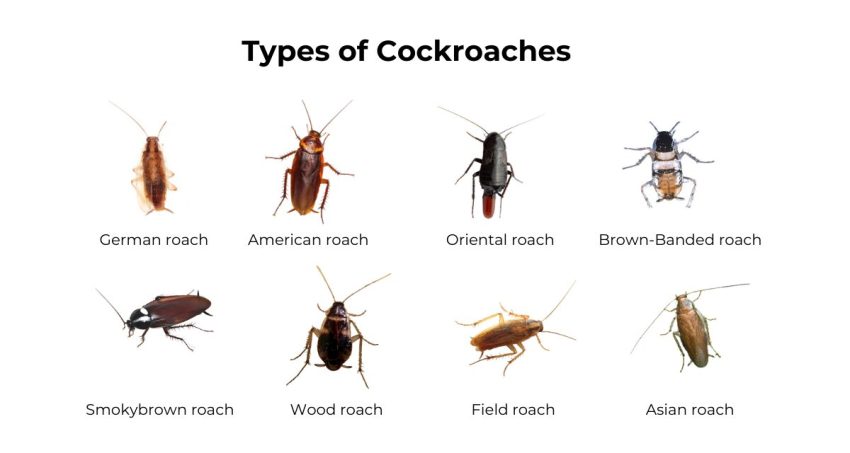Cockroaches are one of the most annoying and hard-to-get-rid-of pests that can invade your home. These insects are tough and can live almost anywhere, making them a common problem. However, not all cockroach types are the same, and each species needs a slightly different approach to get rid of them.
Knowing how to identify the different types of cockroaches in your home is an important first step in controlling them. From the small and quick German cockroach to the large and tough American cockroach, each type has its look, habits, and hiding spots. In this guide, we’ll show you how to recognize the most common cockroach species so you can deal with them effectively and protect your home.
Why Is It Important to Identify Cockroach Types?
Different cockroach species exhibit unique behaviors, habitats, and diets. Understanding their traits will help you:
- Determine their hiding spots.
- Use the most effective extermination methods.
- Prevent future infestations.
The following article outlines identification methods for the most typical cockroach species.
1. German Cockroach
German cockroaches appear among the most common pest species found inside residential homes.
How to Identify German Cockroaches:
- Size: Small, about 13–16 mm long.
- Color: Light brown with two dark brown parallel stripes running behind their head.
- Wings: Present in both males and females, but they rarely fly.
- Behavior: Prefers warm, humid environments like kitchens and bathrooms.
Key Facts:
- Each female egg-laying capsule contains between 30 to 40 eggs.
- German cockroaches prefer living in areas around food sources which creates health risks to people.
- German cockroaches stand out as the most common roach species which invade domestic homes.
Where to Look:
- Hidden gaps and tight spaces around sinks, stoves, and refrigerators.
- Cabinets and drawers with access to food crumbs.
2. American Cockroach
The American cockroach holds the status as both the largest and most visible species of cockroach which exists actively in the world today.
How to Identify American Cockroaches:
- Size: American cockroaches evolve to massive proportions because they can grow up to 53 mm in length.
- Color: Their body presents a reddish-brown coloration while a yellow band sits above their head.
- Wings: Both males and females have fully developed wings and can glide short distances.
Key Facts:
- They can live up to two years, making them long-term pests.
- Usually found in basements, sewers, and wet areas.
- A common pest in apartments due to their attraction to moisture and food sources.
Where to Look:
- Near plumbing, drains, or moist areas in basements and crawlspaces.
- Storage areas with cardboard boxes, which they love to hide in.
3. Brown-Banded Cockroach
The brown-banded cockroach is smaller and less common than the German and American cockroaches but is still a persistent pest.
How to Identify Brown-Banded Cockroaches:
- Size: Small, about 13 mm long.
- Color: Reddish-brown with two distinct light yellow bands across their bodies.
- Wings: Males have functional wings and can fly, while females have shorter wings and cannot.
Key Facts:
- This species is known for jumping when disturbed.
- They live an average of three to 11 months, reproducing quickly during their lifespan.
Where to Look:
- Inside furniture, behind picture frames, and in electrical appliances.
- High areas like shelves or ceilings, unlike other cockroach species.
4. Oriental Cockroach
The Oriental cockroach receives its common name of “water bug” because it inhabits mainly moist environments.
How to Identify Oriental Cockroaches:
- Size: The female Oriental Cockroach reaches a maximum length of 32 millimeters and the male counterparts remain at 25 millimeters.
- Color: Color identification marks the Oriental cockroach by its dark brown or black gloss finish.
- Wings: Males have short wings, but neither males nor females can fly.
Key Facts:
- Feeds primarily on decaying organic matter, which gives them a strong, unpleasant odor.
- Their lifespan is typically around six months.
Where to Look:
- Basements, drains, and areas with poor sanitation.
- Outdoors in leaf litter, mulch, or trash bins.
Common Cockroach Habitats in Homes
While each species has unique preferences, cockroaches are generally drawn to the following areas:
- Kitchens: Near food, water, and warmth.
- Bathrooms: Inside cabinets, drains, and under sinks.
- Storage Areas: Cardboard boxes, cluttered corners, and dark spaces.
- Basements and Garages: Humid, dark places with minimal disturbances.
Tips for Effective Identification
- You should use a flashlight since cockroaches primarily become active at night and during early morning hours to search for indications of their presence.
- People can detect cockroach droppings through their appearance because the droppings of various species resemble black pepper or coffee grounds.
- The identification of different species becomes simpler through the examination of their specialized egg capsules.
- The scent of a musky odor is a sign of Oriental cockroaches.
How to Control Cockroaches Once Identified
Set proper cockroach control measures once you determine which type of roach infests your home.
Sanitation: Keep your kitchen and bathroom clean. Place food items inside sealed plastic containers then empty waste out from the trash regularly.
Sealing Entry Points: You must seal all entry points through door and window fractures as well as plumbing system openings.
Use Baits and Traps: Baits and traps represent effective measures for placing near the areas where cockroaches hide. Sticky traps can monitor infestations.
Insecticides: Use insecticides specifically designed for cockroaches to eliminate infestations effectively. Apply them to baseboards, under appliances, and inside cabinets.
Professional Pest Control for Cockroaches: The persistent cockroach infestation demands professional help from pest control experts who will eliminate the problem.
How to Prevent Future Cockroach Infestations
- Regularly clean and declutter your home.
- Resolve all leaking spots and remove all areas with standing water.
- Before taking grocery bags and boxes or purchasing used items into your home you must check each one for signs of cockroaches.
- Seal off doors along with windows by installing weatherstripping.
Say Goodbye to Cockroaches with Vanquish Pest Control
Eliminating cockroaches can be difficult but Vanquish Pest Control simplifies the process for you. Our experts use specialized and environmentally friendly treatments to identify then eliminate common household cockroaches together with other types of cockroaches through customized residential pest control solutions. Our company implements preventive measures which help stop their return. Vanquish Pest Control offers a free consultation for home protection that will keep cockroaches out of your space permanently. Reach out to us today.
Conclusion
A home infestation by cockroaches becomes simpler to manage. Learning to recognize the various cockroach species enables you to develop specific methods for effectively dealing with the problem. A combination of proper sanitation practices along with efficient sealing of entry points and proper trapping methods allow you to eliminate cockroaches in your home environment. The pest control service provided by Vanquish Pest Control creates custom solutions to eliminate bugs for persistent cases of infestation. Our expert team is available now to give you professional help to protect your home and maintain your peaceful state of mind.
FAQ
Where do cockroaches typically hide in homes?
Cockroaches thrive in warm, dark, and moist areas like kitchens, bathrooms, basements, and storage spaces. They sneak into tight spaces like under appliances, behind furniture, and inside small cracks.
What are the indicators of a cockroach infestation?
Property infested by cockroaches shows several characteristics which include pepper-shaped droppings combined with musty odors and egg capsules called oothecae along with actual cockroach sighting that happens mostly at night.
How can I stop cockroaches from returning?
Future cockroach infections can be prevented through regular home upkeep as well as leak repair and thorough examination and sealing of all openings and crevices before you bring items inside.

